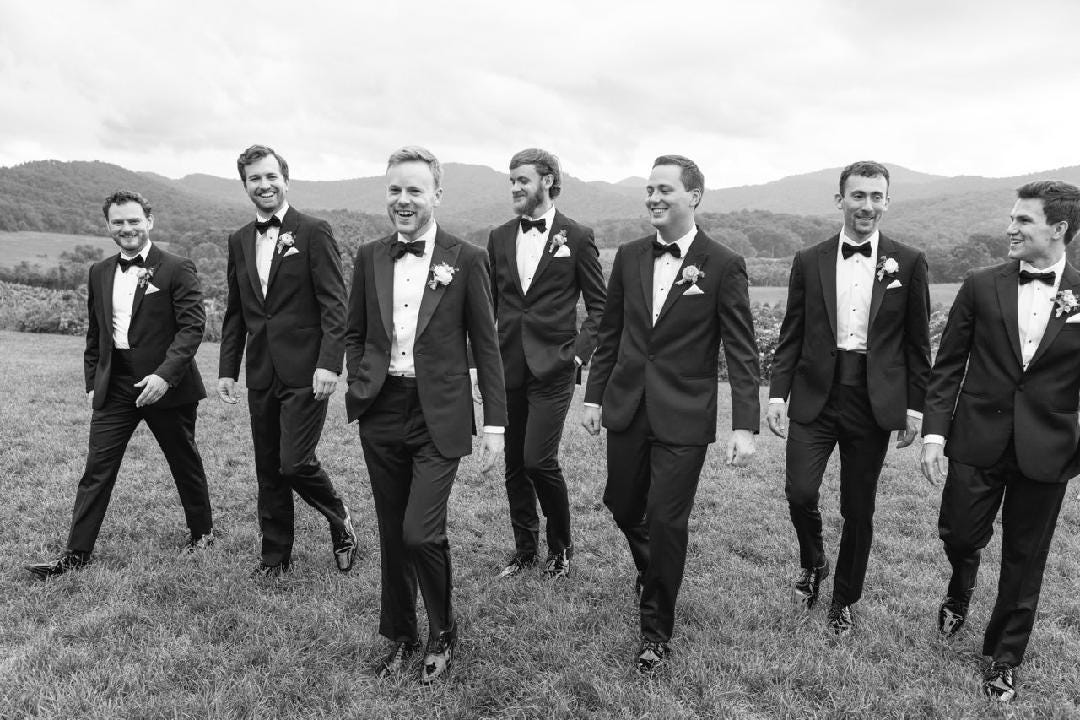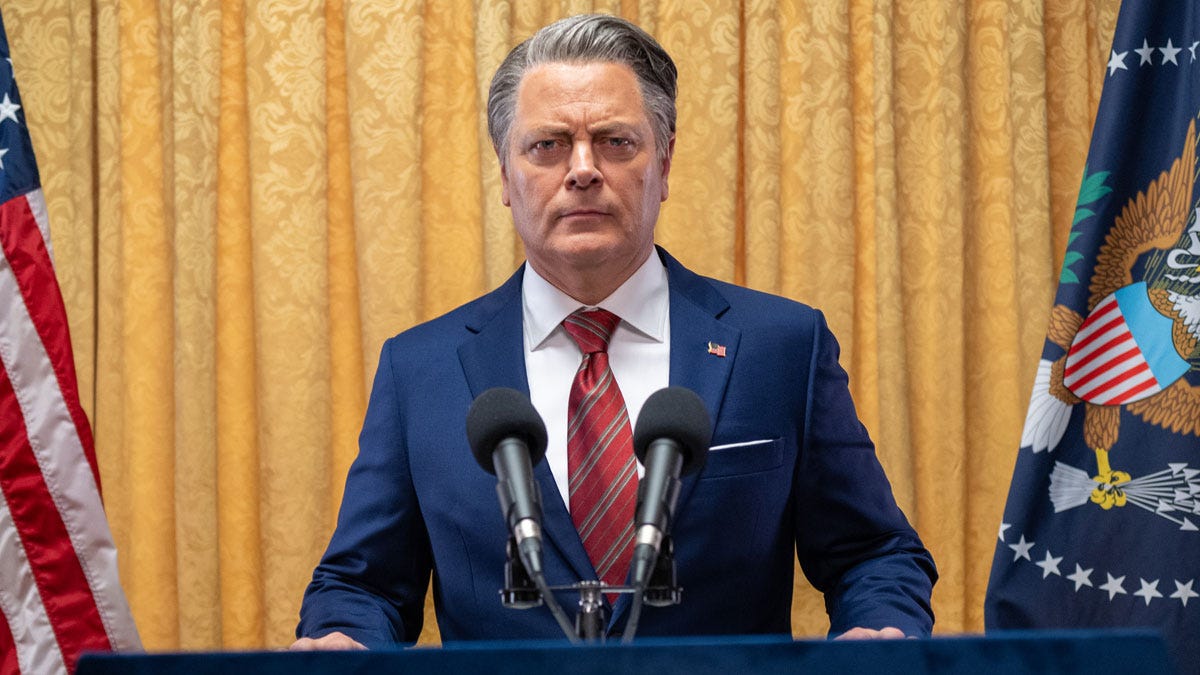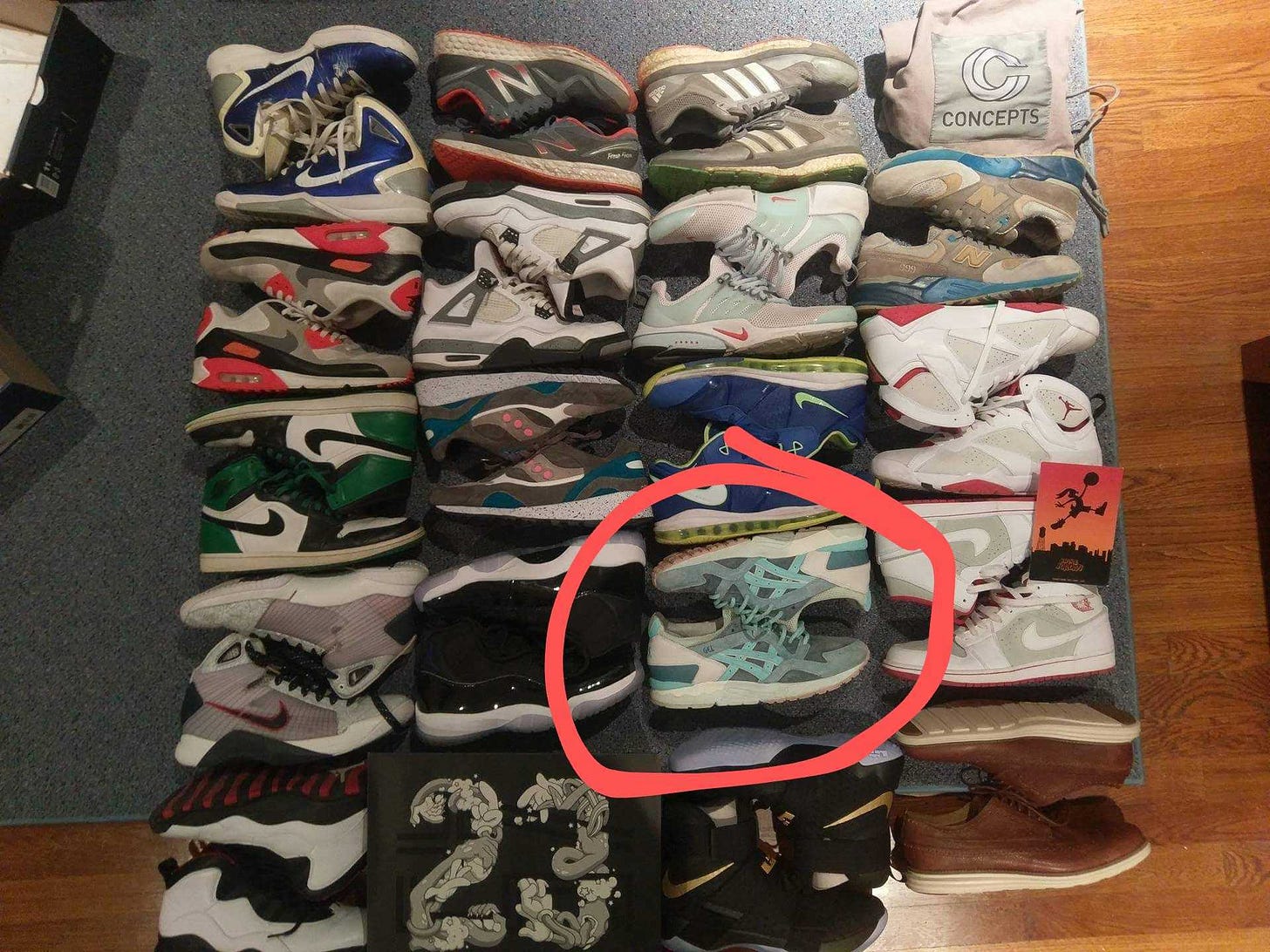Five Things I Think (I Think) 🌎
A note on worldbuilding
Last weekend, I believe, marked the second time I’d ever worn a tuxedo.
It is not often you’ll find me wearing anything other than a graphic tee, shorts, and sneakers. But even if I struggled with figuring out how to tie a (clip-on) bow tie, I still had a ton of fun at my brother’s wedding in Charlottesville, Virginia.
This was only my third wedding as an adult, and I’ve come to view them as canonical multiverse events. All of these different people, all from different universes, coming together in this one place, at this one time.
It’s a beautiful thing—and it makes you appreciate friends and family that much more. In any event, congrats to the newlyweds,* who indirectly inspired the first essay for this week.
— NGL
P.S. I’ve been working on a short film for a while now, and it’s dropping soon! Stick around until the end for a teaser 👀
P.P.S. Last week, I wrote about airline safety videos, the “journalist” vs. “influencer” discourse, and R.F.K. Jr.’s public relations team. If you missed it, check it out here.
I think worldbuilding sets the foundation, then characters and plot carry a story. On my flight back to Los Angeles, I finally watched Civil War (2024). Written and directed by Alex Garland (of Ex Machina and 28 Days Later fame), the A24 blockbuster depicts a not-so-distant future where a group of journalists descends on the White House in an attempt to capture the waning moments of an authoritarian president.
The film received overall positive reviews when it came out in April, ultimately grossing over $122 million worldwide. And I thought it was really powerful! Garland’s visually-arresting style simultaneously makes you feel like you’re on the streets of war-torn D.C. with his protagonists (via the use of handheld cameras), while mixing in harrowing imagery from the sky—like when troops from the secessionist “Western Forces” blow up the Lincoln Memorial.
A common critique of Civil War is the pacing. After some initial fireworks, things move pretty slowly up until the climactic showdown in D.C. We spend a lot of time with the journalists in rural Pennsylvania and West Virginia, as the group comes to terms with how the country has descended into the type of moralless warzone they’re used to seeing abroad.
I actually felt like the slower moments were really poignant. I wouldn’t say I necessarily enjoyed spending time in this world because, well, let’s face it: Garland’s vision is pretty dark. But I did appreciate how the perilous experiences the journalists face served as a humanistic lens—both literally and metaphorically—into a pretty large subject (a second U.S. Civil War).
It’s effective for getting the story off and running. The tradeoff here is that we’re thrown into a world with lots of spectacle—but missing some pretty vital substance.
Save for a brief mention of Nick Offerman’s president being in his “third term” (which certainly feels like a nod to Trump), there’s no explanation as to why California and Texas teamed up to topple the government. Garland, a Brit, has claimed in interviews that this was intentional, as he wanted to make the story feel timeless and not play into a “left versus right” dynamic. Yet the lack of exposition lowers the stakes when the WF finally descends on Offerman in the White House.
In his provocative 2017 essay “Against Worldbuilding,” video game writer Alexis Kennedy references Lord of the Rings in making the case that stories don’t need 5,000 years of “invented history” in order to be good. J.R.R. Tolkien was simply a “philology nerd who loved languages,” Kennedy writes. However, he argues that we remember Tolkien’s world because of the sights and stories it provided when we stopped in for a visit; the rest of the lore is more connective tissue—or “plumbing.”
“I wouldn't want to live in a building without plumbing. But I wouldn't want to visit a building where the architect had sat down at his desk and said “‘Okay, this building is all about the plumbing.’”
If it came down to it, I’d take the version of Civil War that made it onto our screens versus one weighed down by too much exposition. Nonetheless, a simple creative thing I took away from the film? Never forget the plumbing.
I think Civil War deserves a spot in my “Top Six Movies From This Millennium About Journalists Doing Journalism” rankings. Last week, I wrote this:
“I generally think that most people don’t even know how journalism gets done anymore because people don’t consume journalism.”
Feeling like you’re one of these people? That’s okay! Consider watching one of the movies from this list…
6. The Interview (2014) — This movie, where Kim Jong-Un gets blown up by a tank as an acoustic version of Katy Perry’s hit song “Firework” plays, is as ridiculous and mediocre as it sounds. But Dave Skylark did accomplish some all-time broadcast work when he got Eminem to reveal his homosexuality on live TV.**
5. The French Dispatch (2021) — Wes Anderson’s ode to the quirky, whimsical nature of New Yorker profile pieces (and the people writing them) does not rank among the most noteworthy films in the director’s vaunted library. Still, I’ll always have a soft spot for what Dispatch says about the role of isolation in creative work—and the magic of collaboration in making a magazine.
4. Anchorman (2004) — The news business can get competitive. Ron Burgundy’s crew accurately depicts how violence is sometimes the answer when fighting for scoops.
3. Civil War (2024) — Kirsten Dunst’s turn as a war photographer shines through the trauma her facial expressions belie. What happens when a journalist builds her career based on an idealistic notion of “objectivity”—and never interferes with the subjects and events she’s documenting?
2. Spotlight (2015) — A murderer’s row of actors portrays the legendary Boston Globe newsroom that took down the Catholic Church’s child molestation ring. Not the lightest topic, yet a great look into how investigative journalists leave no stones unturned.
1. Almost Famous (2000) — One of my personal favorite movies, Cameron Crowe’s semi-autobiographical, coming-of-age classic depicts a young journalist, William, sent to write a Rolling Stone cover story on an up-and-coming band. Come for how William navigates a profile on the band’s interpersonal squabbles with their desire to be famous; stay for Philip Seymour Hoffman’s absolute heater of a performance as William’s mentor, a veteran music editor with a knack for monologues.
I think Kith is on another level right now. Many streetwear brands have attempted to outgrow their Gildan-tees-and-plastisol-ink roots by knocking on the doors of the high fashion world. Few are doing it as well as designer Ronnie Fieg and his flagship label, Kith.
I fell in love with Kith when Fieg released his “East Coast Pack” Asics collaboration in 2013. Blue-and-orange adorned the pair of Gel-Lyte IIIs inspired by Fieg’s love for the New York Knicks (a franchise where he now serves as creative director as of 2022), but the sneakers’ resale value remained a little too elusive for my middle school wallet.
Fast-forward two years, and High School Sophomore Nate got lucky, copping a pair of Fieg’s “Sage” Gel-Lyte Vs—a pair I still wear to this day.
I’ve been hit-or-miss on new releases ever since, though Kith’s rising prices (and notoriety) haven’t exactly made it easy. Still, I do feel some weird sense of pride in seeing one of my favorite designers grow up, working with the likes of Martin Scorsese and LaKeith Stanfield as he rolled out Kith’s collaboration with Giorgio Armani last week.
A lot of my love for storytelling and design comes from the wonder of sneaker and streetwear collabs. That’s an essay for another day.
I think we’re past the point where celebrities can move on from road bumps by flooding the internet with content. “Has there ever been as clear a loser as Drake?” culture writer Brady Brickner-Wood opens in his recent essay, “How Drake Lost the Plot.”
Brickner-Wood isn’t just referring to Kendrick Lamar’s “Not Like Us” knockout punch. He’s talking about everything Drake has done since losing the biggest rap beef in years—mainly, the decision to release a “documentary-cum-data” dump last month on a lofi site called “100 Gigs for Your Headtop.” Folders upon folders house unreleased tracks and never-before-seen footage from Drake’s recording sessions. It’s too much for any one individual to comb through, an intentional move that would make Selina Meyer proud.
Yet this idea of bucking a traditional “narrative reset” via a magazine profile or Netflix documentary and instead giving the people what they supposedly want (more #content) doesn’t work, Brickner-Wood writes. Because the overwhelming amount of footage “does not communicate the fabric of Drake’s inner life…leaving listeners to imagine Drake alone on his estate, surrounded by riches yet ridden with shame.”
The most interesting part of Brickner-Wood’s essay, however, might have been a reference to a different essay, this one by Rachel Kushner:
“You can encounter a celebrity but you cannot know one, because the very status of celebrity is born of image and of distance—of unknowability. Celebrity is a projection that will dissolve upon genuine contact.”
I certainly subscribe to the notion that mainstream celebrity has died, instead fracturing into millions of different people and brands online. Many of those people and brands build their niche “fame” by presenting themselves as knowable through their vlogs and IG stories.
There’s a lot more ink to be spilled on how parasocial relationships will affect an entire generation of consumers—we still don’t actually know the creators we watch on YouTube. But I do feel like this is the main reason why Drake’s attempt at saving grace rang so hollow. Can we ever really connect with someone whose appeal was always best enjoyed at a distance?
I think we need to stop saying “can’t wait to see what you do next.” I see this sentiment a lot in YouTube comments for up-and-coming creators, and I’ve even heard someone say it to me verbally. And while I don’t believe the phrase is put out there with malintent (it’s a compliment!) I’m still reminded of this tweet from gymnast Simone Biles during the Olympics last month:
There’s always a next mountain to climb, and new peaks to reach. And that’s exciting! But why can’t we celebrate a big project or achievement in the present for what it is, and the work that went into getting there…as opposed to always focusing on the future, and that elusive thing called “potential?”
At the end of 2021, I started documenting my time building Powder Blue. Not just my creative work—moments to check in with where I was at as a recent college grad taking a swing on something he believed in.
A lot has happened since then. I transitioned out of “founder mode”*** and into a new position; I moved from Chicago to DC, then DC to Los Angeles. Throughout that time, I haven’t stopped thinking about what it means to “build.” A career, or a company, sure. But also a life, and relationships with those around us.
I’m calling this short film buildin’. I’ll be releasing it in the next couple of weeks— more on that next Sunday. In the meantime, you can watch the cold open above. Let me know what you think!
Thanks for reading! And shoot me a reply or DM if anything resonated with you in particular—I respond to them all.
* I learned this week that true DC clout is getting your wedding into an edition of Politico’s “Playbook” newsletter. Pop off, Jake and Naomi.
** Remember when North Korea hacked Sony and tried to stop the studio from releasing The Interview? Highly recommend this new narrative podcast from The Ringer that documents that crazy moment in 2014—and how even President Obama got involved.
*** lol








